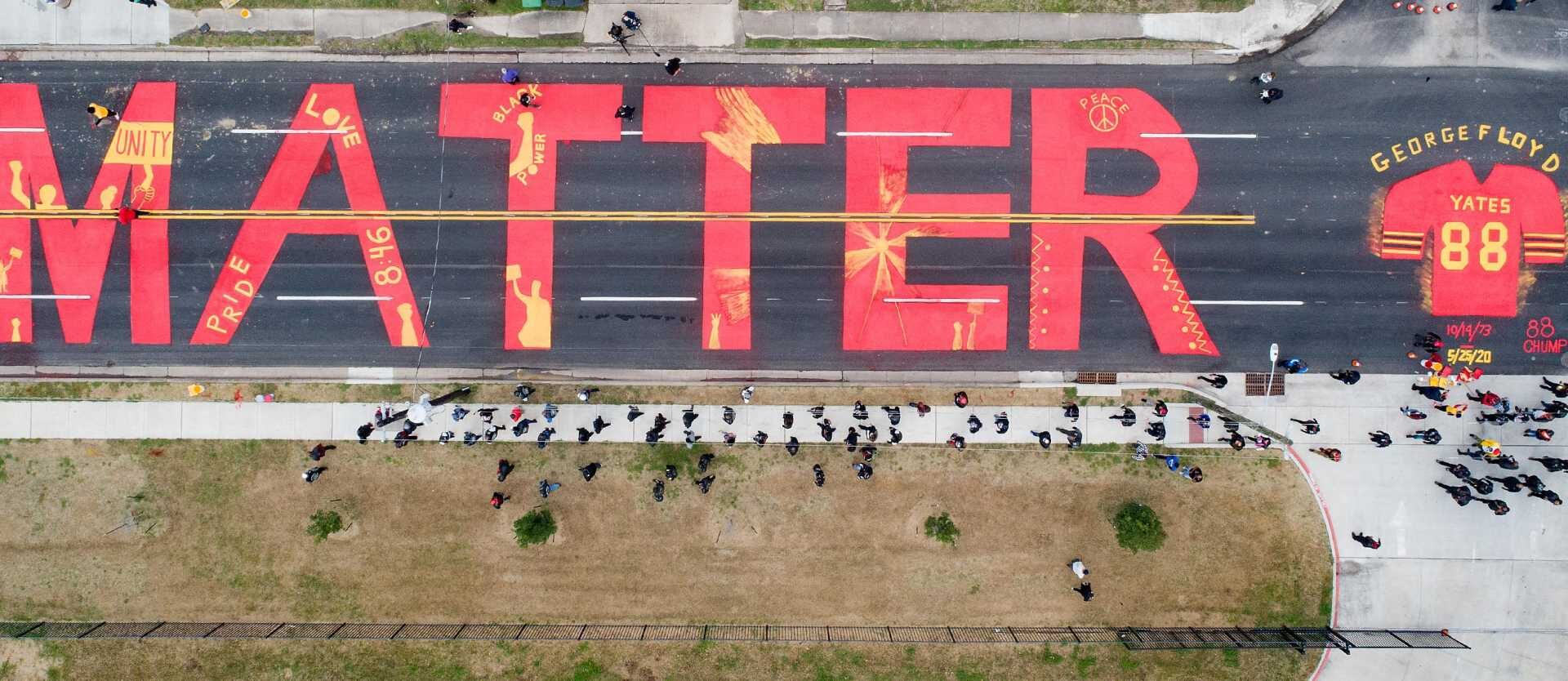Texas Gov. Greg Abbott has declared war on street art, mandating the removal of rainbow crosswalks celebrating LGBTQ+ Pride across the state. But the governor’s crackdown on what he calls “political ideologies” and “distractions” on roadways threatens another symbol of social justice in Houston.
“George Floyd was one of our own. His death was horrific,” Evans-Shabazz, who represents Houston’s District D, where the mural can be found, told KPRC. “Certainly, we wanted to make it clear that Black Lives Matter.”
First painted in 2021, the mural runs along the walls of Jack Yates High School, the school Floyd attended as a high school athlete. Next to the words “Black Lives Matter” is a jersey featuring Floyd’s high school football number, 88. Much like the rainbow crosswalks in the city’s Montrose neighborhood, which symbolize LGBTQ+ pride and memorialize the victim of a hit-and-run, the tribute to Floyd was not paid for with public money. Instead, community members funded the project.
On Wednesday, Abbott released an order directing the Texas Department of Transportation to withhold road funding from cities and counties that do not remove artwork that Abbott alleges represent “political ideologies.” While no examples were cited, Abbott’s order came just days after far-right activist Chaya Raichik, who goes by the moniker Libs of TikTok on X, complained about the repainting of the rainbow crosswalk at Westheimer and Taft St. in Montrose. Abbott’s order spurred additional threats from TXDOT, and in response, several Texas cities have said they plan to remove rainbow crosswalks and other street artwork. Abbott’s order follows similar actions from both the federal government and the state of Florida.
Evans-Shabazz told KPRC that while nobody from TXDOT or the City of Houston has reached out to her about the Floyd tribute, she expects that it will be removed. Houston METRO has already committed to removing the rainbow crosswalk in Montrose. Chron reached out to both METRO and Evans-Shabazz’s office for more information. When asked if METRO was reviewing the street mural, METRO referred Chron only to TXDOt’s guidance.
“I don’t consider it to be a distraction,” Evans-Shabazz told KPRC. “I’m fully aware of what’s coming down from the state in this conversation.”
A review of TXDOT’s open-access crash data showed just two crashes caused by distracted driving along the mural’s length on Alabama St. in the years since it was painted. Evans-Shabazz told KPRC that while state leaders may try to remove the mural, they can’t remove what it represents.
“Removing these symbols of love from the sidewalks and from the streets will not remove it from the hearts and minds of the people,” she told the station. “But what will also not be removed will be the insecurities of those who want them removed.”
The mural serves not just as a tribute to Floyd, a Black man who was murdered by a white Minnesota police officer in 2020, but as a reminder of his roots in the Houston area. Before his move to Minneapolis, Floyd grew up in Third Ward, the city’s historically Black neighborhood. He played basketball and football at Yates High School and attended Texas A&M University-Kingsville before dropping out.
Floyd returned to Houston in the mid ’90s, where he rapped under the name Big Floyd with Screwed Up Click, the legendary Houston hip-hop collective that pioneered the chopped ‘n screwed sound that became pervasive in Southern hip-hop. Floyd would serve time in jail between 1997 and 2005 for drug possession and theft. But after his release, Floyd became involved with various charities and ministries, including the Angel By Nature Foundation charity founded by local rapper Trae Tha Truth. Floyd moved to Minneapolis in 2014 to rebuild his life and find work.
Floyd’s killing at the hands of Derek Chauvin, a white police officer, highlighted police violence against Black Americans and galvanized protests against police brutality across the world in 2020. His death also spawned countless tributes in the form of public artwork, some of which have been removed in recent years. Earlier this year, following the swearing in of President Donald Trump, Washington, D.C. removed a massive “Black Lives Matter” mural. And in Houston, a mural dedicated to Floyd was destroyed when the Third Ward building it was attached to was demolished.

